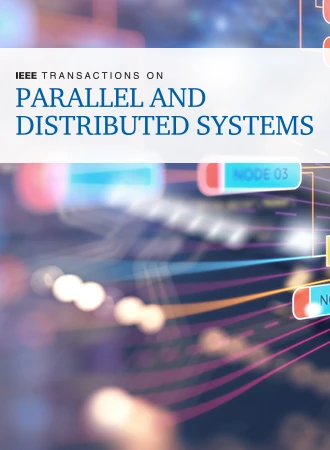网格中成对的多对多 2-Disjoint 路径覆盖
IF 6
2区 计算机科学
Q1 COMPUTER SCIENCE, THEORY & METHODS
IEEE Transactions on Parallel and Distributed Systems
Pub Date : 2024-08-16
DOI:10.1109/TPDS.2024.3445283
引用次数: 0
摘要
在成对的多对多 $k$-disjoint path cover($k$-DPC)问题中,给定图 $G$ 的一组 $k$ 对顶点 $(s_{i},t_{i})$,1\leqslant i\leqslant k$,我们要找到其末端顶点是这 $k$ 对的 $k$ 简单顶点-disjoint 路径,从而使 $G$ 的每个顶点都被路径覆盖。这个问题是并行处理中的一个著名问题,也是著名的哈密顿$(s,t)$路径问题的一般化,相当于 1-DPC。在本文中,我们考虑的是网格(矩形网格)中成对的多对多 2-disjoint 路径覆盖问题(2-DPC)。我们给出了这种覆盖存在的必要条件,并提出了一种计算这种覆盖的线性时间算法。尽管成对的多对多 $k$-isjoint 路径覆盖问题在并行处理中是众所周知的,但我们研究这个问题的动机是它在解决实体网格图中的哈密顿路径问题中的应用。我们考虑的情况是,顶点对位于图的外侧。本文章由计算机程序翻译,如有差异,请以英文原文为准。
Paired Many-to-Many 2-Disjoint Path Covers in Meshes
In the paired many-to-many
$k$ $k$ $k$ $(s_{i},t_{i})$ $1\leqslant i\leqslant k$ $G$ $k$ $k$ $G$ $(s,t)$ $k$
求助全文
通过发布文献求助,成功后即可免费获取论文全文。
去求助
来源期刊

IEEE Transactions on Parallel and Distributed Systems
工程技术-工程:电子与电气
CiteScore
11.00
自引率
9.40%
发文量
281
审稿时长
5.6 months
期刊介绍:
IEEE Transactions on Parallel and Distributed Systems (TPDS) is published monthly. It publishes a range of papers, comments on previously published papers, and survey articles that deal with the parallel and distributed systems research areas of current importance to our readers. Particular areas of interest include, but are not limited to:
a) Parallel and distributed algorithms, focusing on topics such as: models of computation; numerical, combinatorial, and data-intensive parallel algorithms, scalability of algorithms and data structures for parallel and distributed systems, communication and synchronization protocols, network algorithms, scheduling, and load balancing.
b) Applications of parallel and distributed computing, including computational and data-enabled science and engineering, big data applications, parallel crowd sourcing, large-scale social network analysis, management of big data, cloud and grid computing, scientific and biomedical applications, mobile computing, and cyber-physical systems.
c) Parallel and distributed architectures, including architectures for instruction-level and thread-level parallelism; design, analysis, implementation, fault resilience and performance measurements of multiple-processor systems; multicore processors, heterogeneous many-core systems; petascale and exascale systems designs; novel big data architectures; special purpose architectures, including graphics processors, signal processors, network processors, media accelerators, and other special purpose processors and accelerators; impact of technology on architecture; network and interconnect architectures; parallel I/O and storage systems; architecture of the memory hierarchy; power-efficient and green computing architectures; dependable architectures; and performance modeling and evaluation.
d) Parallel and distributed software, including parallel and multicore programming languages and compilers, runtime systems, operating systems, Internet computing and web services, resource management including green computing, middleware for grids, clouds, and data centers, libraries, performance modeling and evaluation, parallel programming paradigms, and programming environments and tools.
 求助内容:
求助内容: 应助结果提醒方式:
应助结果提醒方式:


